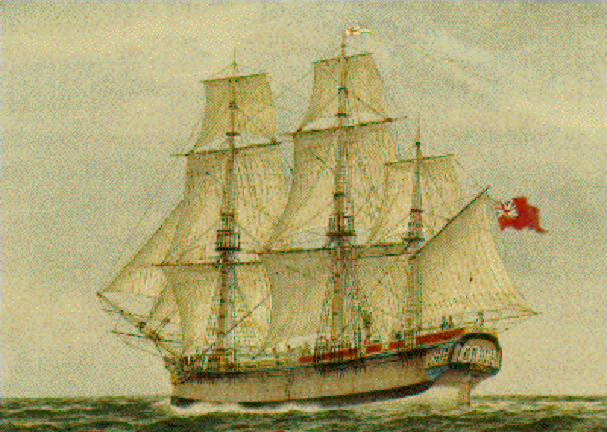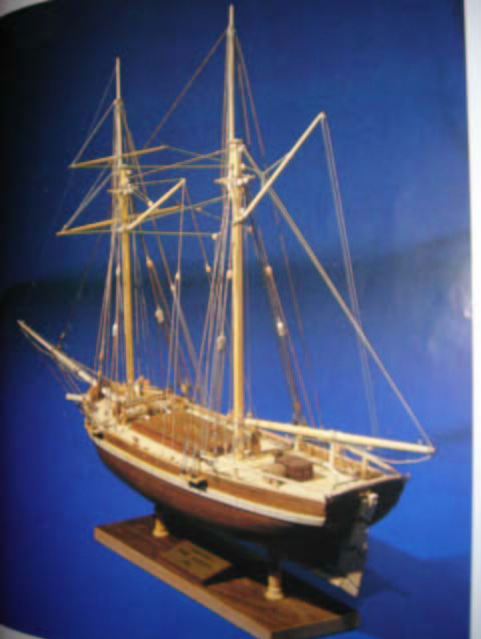The Merchant ship
BERWICK was built for the Baltic trade, but while still on the
stocks, she was purchased by the Royal Navy for use as an armed
transport. After five years in service between Britain and North
America, she was renamed HMS SIRIUS and fitted out for service as
flagship of the “First Fleet” sent out to Botany Bay to establish a
European settlement in Australia. While the expedition has often
been derided as nothing more than an expedient measure to rid
England of criminals, in fact it was part of a well considered plan
to establish a firm British presence in the Pacific as a
counterweight to the Spanish in the Americas and the Philippines,
and the Dutch in the East Indies. Nor was the idea of
“transportation” of convicts new; the policy originated in 1717 and
previous destinations included Africa and the American colonies.
 HMS
SIRIUS was considered a 6th rate with an armament of 10 cannon. She
was 110.4 feet in length, 32.8 feet beam and had a depth of 12.9
feet with a tonnage of 512 bm. She was entirely of wooden
construction with a compliment of 160 men and officers. Her armament
consisted of 4 each 6-pounder cannon and 6 each 18-pound cannon. She
was constructed by Christopher Watson of Rotherhithe, England in
1781. On May 13, 1787, sixth-rate SIRIUS sailed from Portsmouth at
the head of a fleet of eleven ships and a total compliment of 1,350
people under Commander and Chief and Governor Arthur Phillip. These
included the convict transports SCARBOROUGH (with 208 male
convicts), ALESANDER (195 men), LADY PENRHYN (101 female convicts),
CHARLOTTE (88 men, 22 women), FREINDSHIP (76 men, 21 females) and
PRINCE OF WALES (1 man, 49 women). There were also the storeships
FISHBURN, GOLDEN GROVE, and BORROWDALE, and the replenishment ship
SUPPLY. The convicts were given a certain amount of freedom in the
ships, which the majority of them seem not to have abused. However,
there was trouble not only from some of the prisoners but from the
crew and guards as well, some of whom were disciplined for mutiny,
disobedience, or sleeping with the women prisoners. The ships sailed
via Tenerife, Rio de Janeiro (where they remained a month), and Capt
Town. Shortly before their arrival at the latter port, convicts and
members of ALEXANDER’S crew conspired to seize the ship but were
thwarted at the last minute, and the ships arrived without further
incident on October 13. Departing on November 12, the fleet broke
into three separate squadrons.
HMS
SIRIUS was considered a 6th rate with an armament of 10 cannon. She
was 110.4 feet in length, 32.8 feet beam and had a depth of 12.9
feet with a tonnage of 512 bm. She was entirely of wooden
construction with a compliment of 160 men and officers. Her armament
consisted of 4 each 6-pounder cannon and 6 each 18-pound cannon. She
was constructed by Christopher Watson of Rotherhithe, England in
1781. On May 13, 1787, sixth-rate SIRIUS sailed from Portsmouth at
the head of a fleet of eleven ships and a total compliment of 1,350
people under Commander and Chief and Governor Arthur Phillip. These
included the convict transports SCARBOROUGH (with 208 male
convicts), ALESANDER (195 men), LADY PENRHYN (101 female convicts),
CHARLOTTE (88 men, 22 women), FREINDSHIP (76 men, 21 females) and
PRINCE OF WALES (1 man, 49 women). There were also the storeships
FISHBURN, GOLDEN GROVE, and BORROWDALE, and the replenishment ship
SUPPLY. The convicts were given a certain amount of freedom in the
ships, which the majority of them seem not to have abused. However,
there was trouble not only from some of the prisoners but from the
crew and guards as well, some of whom were disciplined for mutiny,
disobedience, or sleeping with the women prisoners. The ships sailed
via Tenerife, Rio de Janeiro (where they remained a month), and Capt
Town. Shortly before their arrival at the latter port, convicts and
members of ALEXANDER’S crew conspired to seize the ship but were
thwarted at the last minute, and the ships arrived without further
incident on October 13. Departing on November 12, the fleet broke
into three separate squadrons.
SUPPLY and the faster transports would arrive early and make
preparations for the arrival of the others. Bad weather slowed
SUPPLY’S progress, and she arrived at Botany Bay on January 18,
1788, only two days before the rest of the fleet, and eight months
and one week since leaving Portsmouth. Dissatisfied with the
situation at Botany Bay, Phillip reconnoitered Port Jackson ten
miles to the north, which he found much more suitable for a colony,
with a better anchorage and more fertile land. The first ships
arrived on January 26 at Sydney Cove, named for Lord Sydney,
Secretary of the Home Office, under whose auspices the First Fleet
sailed. On the same day, SIRIUS and the nine remaining ships were
attempting to leave Botany Bay when they encountered Jean-Francois
de La Perouse’s ASTROLABE and BOUSSOLE. The French explorers
remained at Port Jackson for several weeks before sailing to their
doom.
The last convicts were finally landed on February 6, and after a
night of
debauchery among the newly released convicts, Phillip established a
colonial government
on the following day. Despite the rough material with which he had
to work, he was
inordinately optimistic about the potential for success. He wrote:
“We have come today to take possession of this fifth great
continental division of the earth, on behalf of the British people,
and have founded here a State which we hope will not only occupy and
rule this great country, but also will become a shining light among
all the nations of the Southern Hemisphere. How grand is the
prospect which lies before this youthful nation.
A short time later, SUPPLY sailed for Norfolk Island, about 1,500
miles northeast of Sydney, to establish another penal colony. In
May, three ships sailed for China to load tea for London. By
September, the colony was dangerously short of supplies, and under
Captain John Hunter, SIRIUS sailed via Cape Horn for Cape Town,
arriving back at Port Jackson on May 9, 1789. After four months of
repairs, Phillip ordered SIRIUS and SUPPLY to carry additional
convicts to Norfolk Island to relieve the strain on the Port Jackson
settlement. Forced by the weather to stand off the island for four
days, o March 19, SIRIUS approached the settlement on Sydney Bay.
The strong current and a sudden wind shift pushed her onto a reef.
As her Lieutenant related, “An anchor was let go on Her first
striking//in less than 10 minutes the masts were all over the side,
the Ship an entire wreck.”
Everything that could be salvaged was taken ashore, but the loss of
the ship and her supplies, together with the addition of the
survivors to the population, tested the island’s resources to the
limit. It was not until August 1791 that the next relief ships
arrived. The location of the wreck of the SIRIUS remained unknown.
It was not until the 1980’s that the Sirius Project excavated the
site in anticipation of Australia’s bicentennial. The ship has
yielded hundreds of diverse artifacts, including iron and copper
fastenings, navigational instruments, a pantograph (used for copying
maps to scale), medical supplies, two carronades, personal effects,
and an aboriginal stone axe, probably obtained as a souvenir at Port
Jackson.
As far as I am aware, there is no kit of the SIRIUS on the market
today. There is a kit model of the “SCHOONER FOR PORT JACKSON”. The
following from the Modeller’s Shipyard catalog in Australia may be
of interest: “In response to many requests we have produced our own
model kit, suited to beginners and experts alike, of a ship of
particular interest to Australians. In September, 1788, only 8
months after the founding of the new colony on the shores of Port
Jackson – now better known as Sydney Harbour, Governor Arthur
Phillip sent a message to his superiors in England:

‘.....the settlement on Norfolk Island and the extent of this
harbour will render two vessels of thirty or forty tons of infinite
service to this settlement. I presume they might be sent out in
frame, but it will be necessary to send a few shipwrights to put
them together, and who, as well as mastmaker.........will be of
great service’.
Fifteen years after Phillip’s original request the plans and
fittings for our Schooner arrived at Sydney Cove. Our model can be
your own piece of Australia’s history.” As far as I am aware, the
kit model is still available, although the original owner of the
Modeller’s Shipyard has retired, according to our honorary member,
Richard Keyes. If any member of the SMA is interested in this kit,
please contact Don Dressel (see letterhead) and he will furnish
information on how this kit may be obtained and the current price of
the kit. It is only available in Australia, as I do not think it is
being imported.

